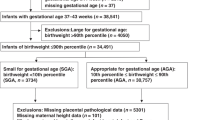Abstract
Objective: To identify risk factors for small-for-gestational-age and preterm in a Portuguese cohort of newborns. Study design: Socio-demographic, anthropometric, behavioural and obstetrical characteristics were evaluated in 4.193 women consecutively delivered. Term small-for-gestational-age (n = 342) and non-small-for-gestational-age preterm (n = 148) were compared to non-small-for-gestational-age term births (n = 3538). Adjusted odds ratios and etiologic fractions were calculated. Results: Low height, low weight when entering pregnancy and low weight gain were significantly associated with small-for-gestational-age, but not preterm. These were the factors with the highest etiologic fraction for small-for-gestational-age. An increased risk of small-for-gestational-age was found for women who smoked during pregnancy (OR = 2.39; 95% CI: 1.66–3.46) and began antenatal care after pregnancy first trimester (OR = 1.86; 95% CI: 1.32–2.62). Previous abortion was associated with small-for-gestational-age (OR = 1.72; 95% CI: 1.16–2.55) and previous preterm with preterm (OR = 3.20; 95% CI: 1.26–8.14). Conclusions: Low anthropometrics, smoking and late antenatal care were risk factors for small-for-gestational-age, but not preterm. Maternal anthropometrics were the factors with the highest impact on small-for-gestational-age. No factor showed a great contribution to preterm birth.
Similar content being viewed by others
References
Peacock JL, Bland JM, Anderson HR. Preterm delivery: effects of socioeconomic factors, psychological stress, smoking, alcohol, and caffeine. BMJ 1995;311:531–5.
Harlow BL, Frigoletto FD, Cramer DW, et al. Determinants of preterm delivery in low risk pregnancies. J Clin Epidemiol 1996;49:441–8.
Berkowitz GS, Blackmore-Prince C, Lapinski R, Savitz DA. Risk factors for preterm birth outcomes. Epidemiology 1998;9:279–85.
Mitchell LE, Bracken MB. Reproductive versus chronologic age as a predictor of low birth weight, preterm delivery and intrauterine growth retardation in primiparous women. Ann Hum Biol. 1990;17:377–86.
Horta BL, Victora CG, Menezes AM, Halpern R, Barros FC. Low birthweight, preterm births and intrauterine growth retardation in relation to maternal smoking. Paediatr Perinat Epidemiol 1997;11:140–51.
Wen SW, Goldenberg RL, Cutter GR, Hoffman HJ, Cliver SP. Intrauterine growth retardation and preterm delivery: prenatal risk factors in an indigent population. Am J Obstet Gynecol 1990;162:213–8.
Abrams B, Newman V. Small-for-gestational-age birth: maternal predictors and comparison with risk factors of spontaneous preterm delivery in the same cohort. Am J Obstet Gynecol 1991;164:785–90.
Arbunckle E, Sherman GJ. Comparison of the risk factors for preterm delivery and intrauterine growth retardation. Paediatric Perinat Epidemiol 1989;3:115–29
Ferraz EM, Gray RH, Cunha TM. Determinants of preterm delivery and intrauterine growth retardation in North- East Brazil. Int J Epidemiol 1990;19:101–8.
Lang JM, Lieberman E, Cohen A. A comparison of risk factors for preterm labor and term small-for-gestational-age birth. Epidemiology 1996;7:369–76.
Thomson AM, Billewicz WZ, Hytten FE. The assessment of fetal growth. J Obstet Gynaecol Br Commonw 1968;75:903–16.
Bruzzi P, Green SB, Byar DP, Brinton LA, Schairern C. Estimating the population attributable risk for multiple risk factors using case- control data. Am J Epidemiol 1985;122:904–14.
Instituto Nacional deEstatística. Estatísticas demográficas. Lisboa 1970–2004.
Buitendijk S, Zeitlin J, Cuttini M, et al. Indicators of fetal and infant health outcomes. Eur J Obstet Gynecol Rep Biol 2003;111:S66–S77.
Demissie K, Rhoads GG, Ananth CV, et al. Trends in preterm birth and neonatal mortality among blacks and whites in the United States from 1989 to 1997. Am J Epidemiol 2001;154:307–15.
Valero De Bernabe J, Soriano T, Albaladejo R, Juarranz M, Calle ME, Martinez D, et al. Risk factors for low birth weight: a review. Eur J Obstet Gynecol Reprod Biol 2004;116:3–15.
Slattery MM, Morrison JJ. Preterm delivery. Lancet 2002;360: 1489–97.
Clausson B, Cnattingius S, Axelsson O. Preterm and term births of small for gestational age infants: a population-based study of risk factors among nulliparous women. Br J Obstet Gynaecol 1998;105:1011–7.
Kok JH, den Ouden AL, Verloove-Vanhorick SP, Brand R. Outcome of very preterm small for gestational age infants: the first nine years of life. Br J Obstet Gynaecol 1998;105:162–8.
Stotland NE, Caughey AB, Lahiff M, Abrams B. Weight gain and spontaneous preterm birth: the role of race or ethnicity and previous preterm birth. Obstet Gynecol 2006;108:1448–55.
Neggers Y, Goldenberg RL. Some thoughts on body mass index, micronutrient intakes and pregnancy outcome. J Nutr 2003;133:1737S–40S.
Abenhaim HA, Kinch RA, Morin L, Benjamin A, Usher R. Effect of prepregnancy body mass index categories on obstetrical and neonatal outcomes. Arch Gynecol Obstet 2007;275:39–43.
Horta BL, Victora CG, Menezes AM, Halpern R, Barros FC. Low birthweight, preterm births and intrauterine growth retardation in relation to maternal smoking. Paediatr Perinat Epidemiol 1997;11:140–51.
Zeitlin JA, Ancel P-Y, Saurel-Cubizolles M-J, Papiernik E. Are risk factors the same for small for gestational age versus other preterm births. Am J Obstet Gynecol 2001;185:208–15.
Kyrklund-Blomberg NB, Granath F, Cnattingius S. Maternal smoking and causes of very preterm birth. Acta Obstet Gynecol Scand 2005;84:572–7.
Burguet A, Kaminski M, Abraham-Lerat L, Schaal JP, Cambonie G, Fresson J, et al. EPIPAGE Study Group. The complex relationship between smoking in pregnancy and very preterm delivery. Results of the epipage study. BJOG 2004;111:258–65.
Nabet C, Ancel PY, Burguet A, Kaminski M. Smoking during pregnancy and preterm birth according to obstetric history: French national perinatal surveys. Paediatr Perinat Epidemiol 2005;19:88–96.
Cnattingius S, Granath F, Petersson G, Harlow BL. The influence of gestational age and smoking habits on the risk of subsequent preterm deliveries. N Engl J Med 1999;341:943–8.
Ahern J, Pickett KE, Selvin S, Abrams B. Preterm birth among African American and white women: a multilevel analysis of socioeconomic characteristics and cigarette smoking. Epidemiol Community Health 2003;57:606–11.
Barros H, Tavares M, Rodrigues T. Role of prenatal care in preterm birth and low birthweight in Portugal. J Pub Health Med 1996;18:321–8.
Kramer MS. Intrauterine growth and gestational duration determinants. Pediatrics 1987;80:502–11.
Author information
Authors and Affiliations
Corresponding author
Rights and permissions
About this article
Cite this article
Rodrigues, T., Barros, H. Comparison of Risk Factors for Small-for-Gestational-Age and Preterm in a Portuguese Cohort of Newborns. Matern Child Health J 11, 417–424 (2007). https://doi.org/10.1007/s10995-007-0195-2
Received:
Accepted:
Published:
Issue Date:
DOI: https://doi.org/10.1007/s10995-007-0195-2




